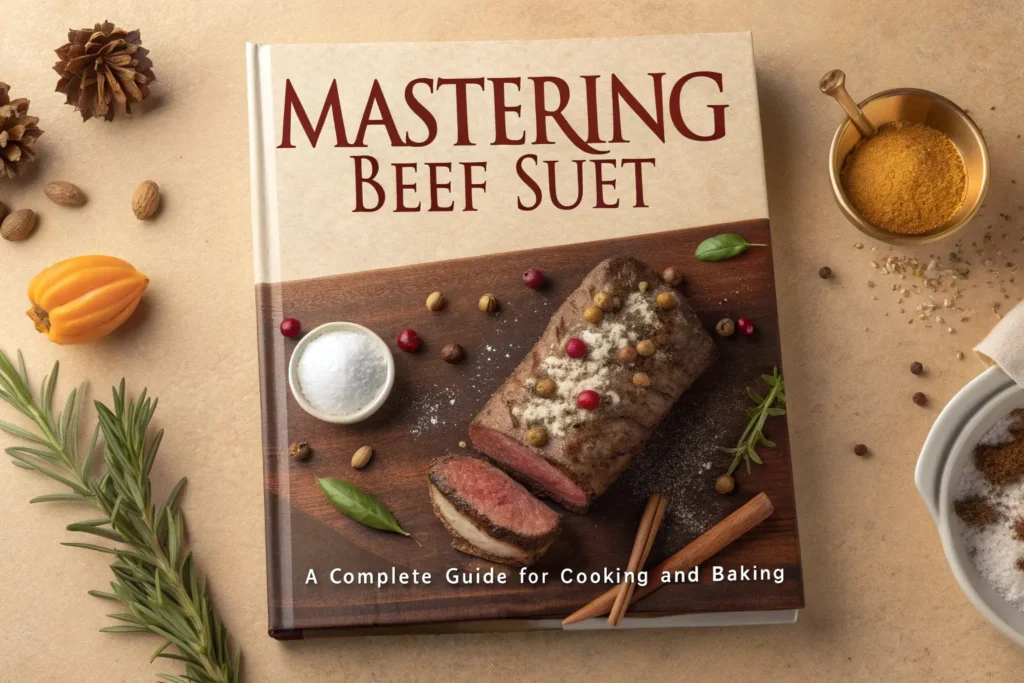Rediscovering the Forgotten Magic of Beef Suet
Have you ever stood in your kitchen, craving the richness of a hearty traditional dish, but felt like something was missing? That “something” could very well be beef suet—an age-old ingredient that’s been quietly pushed aside in the modern rush toward convenience cooking. Yet, it holds a power that goes far beyond flavor.
Beef suet connects you to a culinary heritage that spans generations. It’s the secret to your grandmother’s fluffy dumplings, your great-uncle’s perfect steak pudding, and those Sunday roasts that seemed to melt in your mouth. When you master suet, you tap into a resource that transforms your cooking from ordinary to unforgettable.
Whether you’re trying to deepen the flavor of your savory dishes or bring a flaky texture to your baked goods, this guide will walk you through everything you need to know about cooking and baking with beef suet.
Table of contents
What is Beef Suet and Why It Matters to Your Kitchen
Understanding Suet: The Hidden Gem in Traditional Cooking
Beef suet is the firm, raw fat surrounding the kidneys and loins of cattle. Unlike regular beef fat, suet has a dry, crumbly texture and a high melting point, making it perfect for high-heat cooking and baking.
If you’re used to butter or oil, switching to suet may seem unconventional. But this pure animal fat brings unique advantages:
- Incredibly rich flavor
- Fluffy, tender pastries
- Crispier fried foods
Nutritional Profile of Beef Suet
Don’t let the word “fat” throw you off. Beef suet is packed with:
- Healthy saturated fats that fuel your energy
- Vitamins A, D, E, and K—essential for immune and bone health
- Conjugated Linoleic Acid (CLA), a fat-burning and anti-inflammatory compound
Fat Comparison Table
| Fat Type | Saturated Fat (%) | Smoke Point (°F) | Keto-Friendly | Flavor Profile |
|---|---|---|---|---|
| Beef Suet | ~60% | ~400 | ✅ | Rich, meaty |
| Butter | ~51% | ~300 | ✅ | Creamy, dairy-rich |
| Lard | ~40% | ~370 | ✅ | Mild, savory |
| Coconut Oil | ~90% | ~350 | ✅ | Sweet, nutty |
When you want a fat that holds up to heat and enriches every bite, beef suet is the way to go.
Where to Find Beef Suet and How to Store It
Buying Tips: Getting the Best Quality Suet
You can find suet in most butcher shops, especially if you ask for it directly. Farmers markets, local ranchers, and online specialty stores also offer high-quality options.
When buying suet, here’s what to look for:
- Look for a pale, dry texture – steer clear of greasy or yellow pieces.
- Kidney fat specifically – This is purer than general beef fat.
- Grass-fed sources – Higher in nutrients and healthier fat profile.
Some stores sell rendered suet (aka tallow), but starting with raw suet gives you more control.
Storage Guidelines
- Refrigerator: Lasts 5–7 days fresh
- Freezer: Can be stored for 6–12 months
- Rendered Suet (Tallow): Store in airtight jars, and it’ll last months at room temperature
Pro tip: Freeze it in small chunks or grated form so you can use only what you need.
How to Render Beef Suet into Tallow (and Why You Should)
What is Rendering and Why It Matters
Rendering is the process of gently melting suet to extract the pure fat (tallow). Once rendered, tallow is:
- Shelf-stable
- Cleaner to cook with
- Neutral in flavor
How to Render Suet: Step-by-Step
- Chop the suet into small cubes or grate it while frozen
- Place in a heavy-bottom pot or slow cooker on low heat
- Let it melt slowly, stirring occasionally
- Strain through cheesecloth to remove solids
- Cool and store in glass jars
Rendering Tips
- Never rush the process; low and slow wins.
- Stir to prevent sticking and burning.
- Add a bay leaf for a hint of aroma.
Once you’ve rendered your own tallow, you’ll wonder why you ever used store-bought oils.
Savory Cooking with Beef Suet: Elevate Every Dish
Why You’ll Love Cooking with Suet
Beef suet shines in high-heat and long-cooking dishes. Whether frying, roasting, or slow-braising, suet:
- Develops crisp textures
- Adds deep, meaty flavor
- Handles high temperatures without smoking
Top Savory Uses
- Frying: Chicken, fish, or chips
- Roasting: Vegetables, especially potatoes
- Pastries: Savory pie crusts with exceptional flakiness

Recipe: Classic Steak & Kidney Pudding
Ingredients Table
| Ingredient | Quantity |
|---|---|
| Grated beef suet | 200g |
| Self-raising flour | 400g |
| Diced beef steak | 500g |
| Lamb kidneys (optional) | 250g |
| Chopped onion | 1 |
| Beef stock | 500ml |
| Salt & pepper | To taste |
Instructions
- Make the pastry: Mix suet and flour with cold water until dough forms.
- Roll out the dough and line a pudding basin, reserving some dough for the lid.
- Fill with steak, kidneys, onion, and stock.
- Cover, seal, and steam for 3 hours.
- Serve hot with rich gravy.
This hearty dish is comfort food at its finest—and it all starts with beef suet.
Baking with Suet: From Flaky Crusts to Sweet Nostalgia
Why Use Suet in Baked Goods?
Suet creates a lighter, moister crumb in baked recipes. Unlike butter, which can weigh down doughs, suet helps:
- Retain steam
- Keep texture airy
- Add subtle richness
Must-Try Suet-Based Recipes
- Spotted Dick – A British classic steamed with dried fruits
- Jam Roly-Poly – Rolled pudding with jam, baked or steamed
- Suet Crust Pie – For sweet or savory fillings
- Suet Dumplings – The perfect topper for a stew
Tips for Better Baking
- Always use cold, grated suet
- Don’t overwork the dough
- Steam your suet puddings slowly for the best results
Suet isn’t just old-fashioned—it’s your ticket to moist, fluffy bakes that melt in your mouth.
Is Beef Suet Good for You? Let’s Talk Nutrition and Myths
Health Benefits
When eaten in moderation, beef suet offers numerous nutritional advantages:
- Energy-dense fuel for active lifestyles
- Rich in fat-soluble vitamins
- Anti-inflammatory effects due to CLA
It’s a go-to for anyone following a:
- Keto diet
- Carnivore diet
- Paleo or ancestral lifestyle
Debunking the Myths
You may have heard that animal fats are dangerous—but new research suggests otherwise. Studies now show:
- Saturated fat doesn’t directly cause heart disease
- Traditional fats are more stable and less inflammatory than processed seed oils
Beef suet is real food, and your body knows what to do with it.
Sustainability and Ethics
- Choose grass-fed suet for better animal welfare
- Rendering and using suet is a zero-waste approach that honors the whole animal
FAQs: Everything You Still Wonder About Beef Suet
What’s the difference between beef suet and regular beef fat?
Beef suet comes from around the kidneys and is cleaner, harder, and better suited for rendering or baking.
Can I use butter or lard instead of suet?
You can, but you’ll miss the unique fluffiness and richness that suet offers, especially in traditional dishes.
How long does rendered suet (tallow) last?
Stored in a cool, dark place, tallow can last 6–12 months without refrigeration.
Can vegetarians use suet?
Traditional suet is animal-based, but there are vegetarian suet alternatives made from vegetable oils, ideal for meat-free baking.
Your Turn: Start Cooking with Confidence
You’ve just unlocked a timeless ingredient that can elevate your meals from basic to brilliant. Beef suet isn’t just for the history books—it’s for your kitchen, your health, and your next unforgettable meal.
Whether you’re rendering it into tallow, whipping up a traditional pudding, or frying the crispiest roast potatoes you’ve ever had—you now have the tools to master beef suetCall-to-Action:
Try using beef suet in your next recipe and share your creation online. Tag your dish with #SuetMastery and let others see how traditional cooking is making a delicious comeback—thanks to you.
Have you given our recipe a try?
There are no reviews yet. Be the first one to write one.

